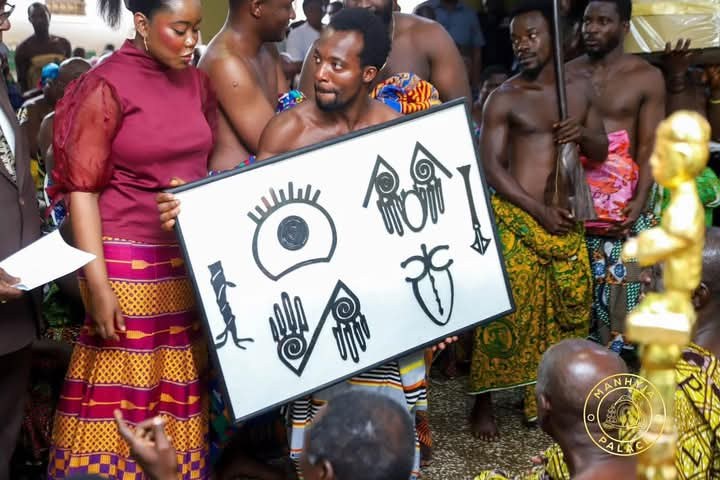Six newly designed Adinkra symbols have been unveiled in honor of Otumfuor Osei Tutu II, the 16th Monarch of the Asante Kingdom, to reflect his reign, values, and enduring legacy. The symbols, developed by Aliska Business Advisory and Research, celebrate the Asantehene’s remarkable contributions to Asante culture, heritage, and national development.
The announcement was made during a presentation ceremony in Kumasi, led by Mr. Agyemang of Aliska, who revealed that the symbols were the result of three and a half years of in-depth research. The team focused on key milestones and the monarch’s influence both within Ghana and internationally.
“These symbols capture the essence of His Majesty’s leadership and his commitment to preserving and promoting Asante arts, tradition, and identity,” Mr. Agyemang stated.
Otumfuo’s Symbols: Culture and Counsel Interwoven
Among the six symbols, “Otumfuor nsa”, meaning “the hand of Otumfuor,” is the only one that has been officially named so far. It reflects the Asantehene’s gentle yet firm guardianship of the Kingdom’s cultural heritage, a leadership style that combines wisdom with humility.
A second symbol depicts two parallel hands, one facing upward and the other downward representing the King’s embrace of diverse cultures and his efforts to foster unity between the northern and southern regions of Ghana.
Another symbol was designed to reflect Otumfuor’s intellectual leadership, showing how governments both local and international tap into his wisdom for strategic governance.
The fourth symbol pays tribute to the Asantehene’s counsel in the management of Ghana’s natural resources, while the fifth shaped like a ceremonial staff with the crest of Manhyia and the Golden Stool signifies his impact on national development.
The final symbol recognizes Otumfuor’s enduring contributions to education and research, especially his efforts to promote academic excellence and innovation in Ghana.
Royal Approval and Historical Reflection
In response to the presentation, Otumfuor Osei Tutu II expressed appreciation and noted the deep symbolism embedded in the designs. He recalled a significant moment during his enstoolment 26 years ago, where a symbolic hand gesture he made went misunderstood by many traditional authorities.
“Twenty-six years ago, when I was going to Pampaso, I symbolically put my hands together, but many chiefs didn’t understand,” His Majesty recounted. “My grandchildren understood it, but many of the chiefs couldn’t understand it at the time.”
His Majesty also revealed that he intends to gift one of the new Adinkra symbols to the visiting King of Eswatini, scheduled to arrive at the Manhyia Palace next week. He has summoned the Aliska team for a follow-up meeting on Friday to finalize the specific design and meaning behind the symbolic gift.
Preserving Heritage Through Innovation
The development of these new Otumfuor Osei Tutu II Adinkra symbols not only adds depth to Ghana’s cultural identity but also underscores the importance of contemporary efforts to preserve and modernize traditional African symbols. By weaving modern leadership achievements into ancient visual languages, the Asante Kingdom continues to reinforce its relevance in a changing world.
Additional Source: Opemsuo Radio.


